As our Alitalia flight took off from Rome’s Leonardo da Vinci Airport for the hour-and-a-quarter trip to Malta, we could not help but overhear the American in the row behind us telling a fellow passenger he would be in Malta for less than 24 hours, just stopping in so he could cross it off the list of countries he wanted to visit. He had already been to 131, along with the North and South Poles, and was planning to make Malta number 132. Now that we have been there too, and heard Malta described repeatedly as “the Mediterranean’s best kept secret,” we can only despair at what he missed on such a short visit. Ours was four times longer but still not enough time to discover all that this fascinating country offers, including its wines, and to know that it shouldn’t be a secret at all.
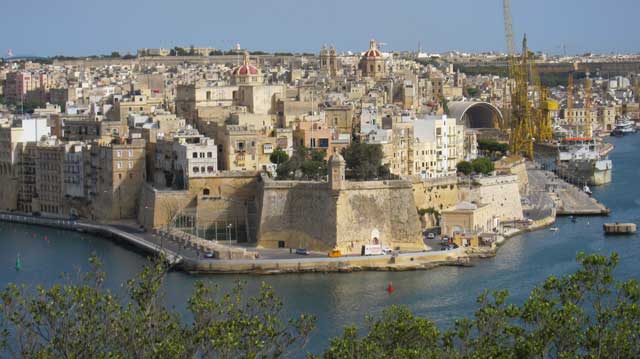
While the island of Malta, largest of five islands comprising the country of Malta, is just 96 square miles with a population of slightly over 400,000 and with a history dating back to 7000 B.C., it was the Knights of Malta who really put it on the map. And that spot on the map, strategically positioned between Sicily and the coast of North Africa, proved a challenge to the Knights and subsequent defenders as recently as World War II. Malta has been a coveted piece of real estate since prehistoric times for anyone seeking to dominate the Mediterranean including the Phoenicians, Greeks, Romans, French, British, and Germans. A part of the British Empire from 1814 to 1964, Malta is an independent country and, since 2004, a member of the European Union.
It was the ancient Phoenicians who gave Malta its start in the wine business and the Knights of Malta who ensured its permanence with members of the Order bringing cuttings from their original homes in France, Italy, and Spain. But after the Knights’ complete expulsion from the island in 1798 by Napoleon, who decided to stop by and conquer Malta on his way to Egypt, arable land was given over to other items such as cotton. Wine was still produced in Malta but using grapes imported from Italy until late in the last century when traditional grape varieties such as Cabernet Sauvignon, Merlot, and Grenache, as well as a local grape called Gellewza, were planted and an indigenous wine industry was reborn.
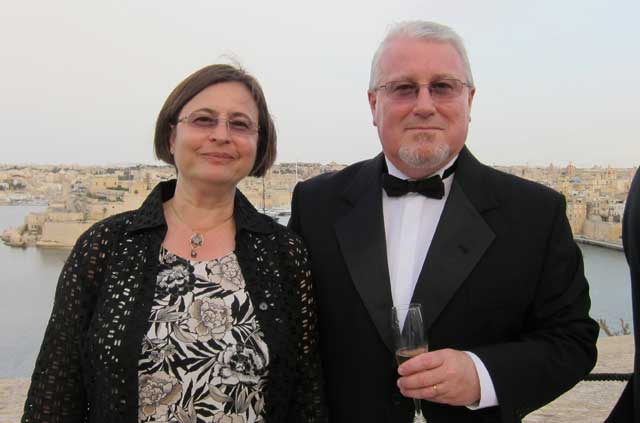
Production of red, white, and sparkling wines remains limited, but we enjoyed some remarkable reds. The best was the Melquart from the Meridiana Wine Estate of Ta’ Qali just below Mdina, the favorite of David Pace, head of UHY Malta and our conference host whose exhortations to visit him in Malta over the last seven years finally paid off. Sadly, visiting a winery was not in the cards for us during this trip.
The Knights of Malta were originally known as the Knights of St. John or the Knights Hospitaller for their religious military order established to care for pilgrims in the Holy Land at the time of the Crusades, and for the hospital they established in Jerusalem and dedicated to St. John the Baptist. Malta wasn’t their first headquarters and likely not their first choice, but after the last Christian stronghold in the Holy Land was defeated in 1291, and then establishing themselves on Rhodes only to be defeated again in 1523 by the Turks, they were granted Malta by King Charles I of Spain in 1530 in exchange for the annual gift of a Maltese Falcon (bestowed to this day).
Included in Spain’s Viceroyalty of Sicily, moving the Knights to Malta was part of Charles’ grand plan to keep the Mediterranean quiet while Spain focused on conquest of the New World. The Turks didn’t buy this, though, and set about trying to conquer Malta in 1565 both by land and by sea. But the Knights held out, just barely, and repelled the Turkish invasion.
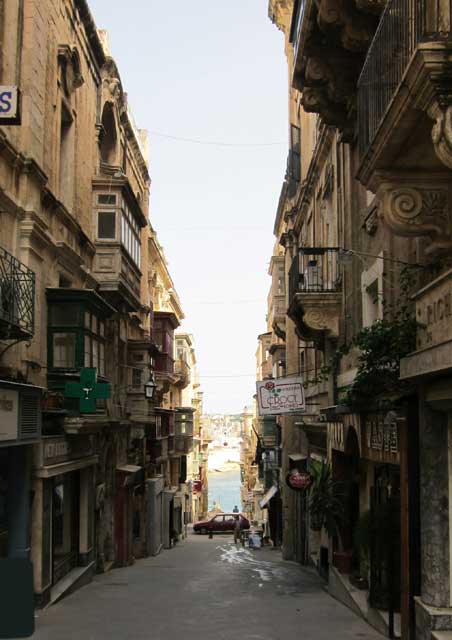
To celebrate their victory, they built the city of Valletta, now the capital of Malta and named for the Order’s Grand Master and leader throughout the Turkish siege, Jean de la Vallette. A magnificent city of light-colored limestone and one the modern world’s first master-planned communities, it sits on a hill overlooking the Grand Harbor with commanding views in all the directions from which an invasion might come. Narrow streets channel cool sea breezes and open out onto wide plazas, all of which are jam-packed on the 15 or so days a month when giant cruise ships dock and their passengers besiege the city’s landmarks.
For a country with such a small population, the architectural and artistic riches are beyond all expectations. In particular, there is the Co-Cathedral of St. John the Baptist in central Valletta. Built as the main place of worship for the Knights and recently restored and re-gilded, it is overwhelming in scale and richness of ornament. On either side of the central area or nave are chapels dedicated to each of the langues or language groups through which the Order, with members hailing from all over Europe, was administered.
Throughout the chapels are sculptures and other monuments to the Knights and their Grand Masters. Spanning the entire length of the vaulted ceiling is an enormous fresco depicting scenes from the life of St. John, rich in trompe l’oeil effects and painted in the late 17th century by Mattia Preti. The floor of the Cathedral is comprised of tombstones in pietra dura for over 400 Knights, each with a brief dedication including name, noble lineage, heraldry, and accomplishments of the individual whose remains rest below it.
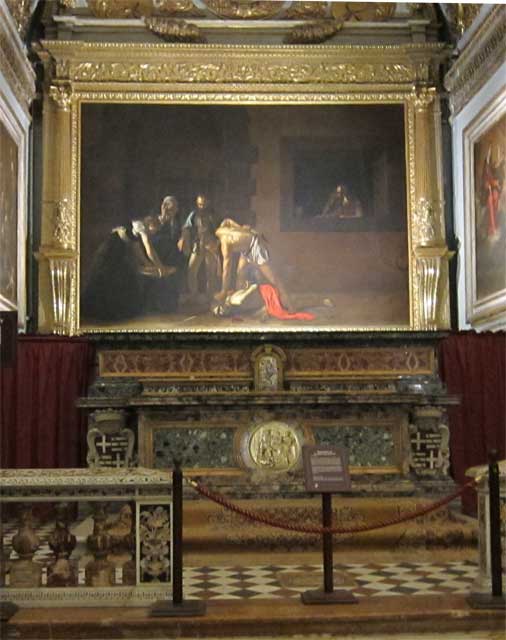
Off to one side of the building is the Oratory. A huge and elaborate room for private prayer, it was built in the early 1600s after the completion of the main part of the Cathedral. The possibility of lucrative commissions attracted Michelangelo Merisi da Caravaggio, the gifted painter whose bad boy reputation had gotten him into trouble back home in Milan, Rome, and Naples, especially after being accused of killing a man in a fight. Legend has it that to grease the skids, so to speak, after arriving in Valletta he painted St. Jerome in His Study and gave the saint a face closely resembling the Grand Master’s. Eventually he joined the Order and landed the commission to paint the Beheading of Saint John as the centerpiece of the Oratory.
We have always admired Caravaggio and his flair for the dramatic while keeping things a bit off balance visually, especially when it comes to the placement of figures and use of light and shadow. He exceled at including elements which might seem out of place, such as the dirty soles of a shepherd’s feet in a Nativity scene, or a partially carved roast chicken. In stories from the Bible, it is as if he comes upon the scene and freezes it in oils at the most dramatic moment. Whether it’s the Supper at Emmaus when the diners realize it is Christ sitting at their table, or the Conversion of St. Paul when the future saint lies sprawled under his horse on the road to Damascus, there is no want of theater.
And so my husband, Michael, and I were looking forward to seeing Caravaggio’s enormous depiction of the beheading of St. John, the only painting signed by the artist -- drawn out in the rivulet of blood that has spurted from the saint’s neck as a servant bends over with a platter ready to scoop up the soon-to-be-severed head. Sadly, we couldn’t get as close to the painting as we had hoped. But it was enough just to glimpse it from afar in the room where the genius created his masterpiece before getting into trouble again, landing in prison, and eventually dying just shy of 37 on his way back to Rome to accept a pardon from the Pope.
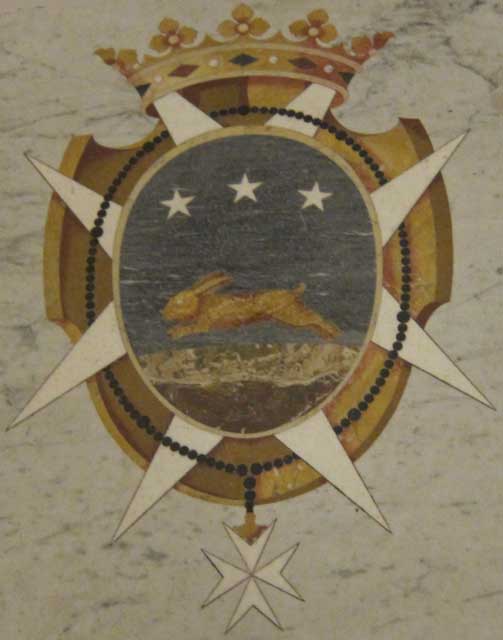
As we turned to leave the Oratory, we noticed one of the tombstones in the floor. It depicted a rabbit soaring over what looked like a cityscape of Valletta and reminded us of what we had learned about Maltese cuisine. An island with little agricultural land, sources of animal protein had been limited to creatures smaller than cows and pigs. Rabbit had proved the meat of choice and is celebrated in Stuffat Tal-Fenek the national dish of rabbit stew. We didn’t try it during our stay but countless restaurants offered it.
Instead we focused on the bounty from the sea on the evening when we dined with French friends Muriel and Raymond at Sale e Pepe, a small, family-owned Italian restaurant overlooking the harbor at Porto Maso. Being French, Muriel was concerned about whether the fish would really be fresh but our waiter brought out a tray of specimens caught that morning from which we could choose. We selected turbot and grouper to be poached on a bed of potatoes, mussels, and clams – a winning combination in a perfumed broth accompanying the moist and flaky fish. Much as we loved our main courses, we had to admit that the starter of fritto misto involved the absolute best squid any of us had ever tasted. A cliché of rubberiness in thick breading and inevitably served with a marinara sauce, calamari are something we typically avoid in the U.S. So the delicately breaded, fried, and utterly tender squid and vegetables, served with a tartar sauce rich in capers and with a slight peppery zing from anchovy paste, proved a culinary highlight of our visit to Malta.
If Malta is the Med’s best kept secret, we shared over dinner what we knew was the best kept secret within the secret – a set of tapestries. Spaniard Ramón Perellos y Roccaful commissioned a set of 29 gigantic tapestries from weavers in Brussels, based on designs by Peter Paul Rubens, as his gift to the Co-Cathedral upon election as Grand Master in 1697. Subjects ranging from New Testament themes to allegories of a Catholic Church triumphant comprise the world’s largest complete set of tapestries. Originally hung from the cornices along either side of the nave, a few are on display in the Cathedral’s museum while others are rolled up along the walls in other rooms, apparently just having come back from the restorers.
Our jaws dropped as we beheld these masterpieces of the weaver’s art, surpassing all others we have seen in terms of virtuosic depictions of flames, pools of water, and stunning effects of textures such as glass, armor, furs, and silks. Regrettably, no photos are permitted and nary a book or even a postcard is to be found in the museum’s shop. We have only our memories and a couple of photos available on the Co-Cathedral’s website, so it looks as though this secret will be kept.
Less secret but equally noteworthy was the Palace Armoury, a museum located in the Grand Master’s Palace and one of the largest collections of armor still housed in its original building. It offers a sizeable selection of the Knights’ armor and weapons including huge and richly ornamented cannons used in the Siege of Malta and later battles as well as suits of armor worn on ceremonial occasions. We had the opportunity to visit with the Curator, Robert Cassar, and we found him an inspiration as we learned of his passion for preserving Malta’s artistic heritage and his dedication to conserving the collection while expanding the museum in the coming years. He was able to divulge at least one secret to us – that the dents appearing to be evidence of a direct hit by a musket ball on some of the breastplates were really just the result of the maker’s bravado in demonstrating the armor’s toughness to a prospective user.
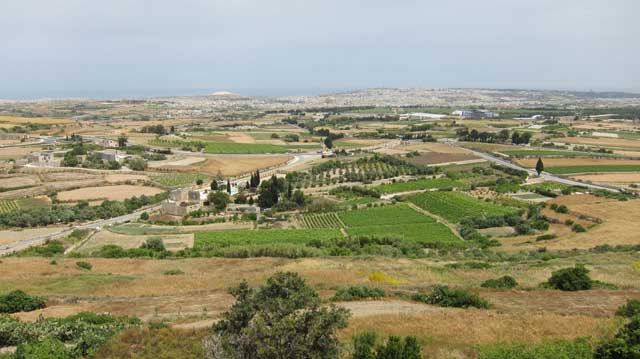
On our last sightseeing foray, to the ancient towns of Mdina and Rabat, we found a location that should definitely not be a secret. Searching for a place to have a relaxing gourmet lunch, we came upon the Xara Palace Hotel. Unfortunately for us, its restaurant was closed for the day due to a wedding taking place at the hotel that afternoon, but we enjoyed looking around the property and marveling at the magnificent antique décor. The possibility of staying in Mdina’s only hotel and enjoying the quiet at nighttime of the deserted town that was the former headquarters of the Knights of Malta, are reason enough to return.
As we headed to the plane on our final day in Malta, including the obligatory exit through the Duty Free store, we stopped to chat with Carlo in the wine department and selected his favorite Maltese red, Marnisi from the Marsovin vineyard, to take back with us to Rome. Free samples of Bajtra Liqueur, a pleasing nectar made from the local prickly pear cactus, led us to pick up a bottle of that as well. Not ready to cross Malta off any list, we’re anxious to go back and experience what we missed, including the rabbit stew.
Saint John’s Co-Cathedral, St. John Street, Valletta
The Palace Armoury, The Grandmaster’s Palace, Palace Square, Valletta
Sale e Pepe, Porto Maso Marina, St. Julian’s
Next time, discovering the bounties of the Campania region while avoiding the staples of Naples.
The original version of this article appeared in the Spring, 2014 edition of the Quarterly Newsletter of the Wine Society of Texas, a non-profit organization dedicated to wine education and appreciation.